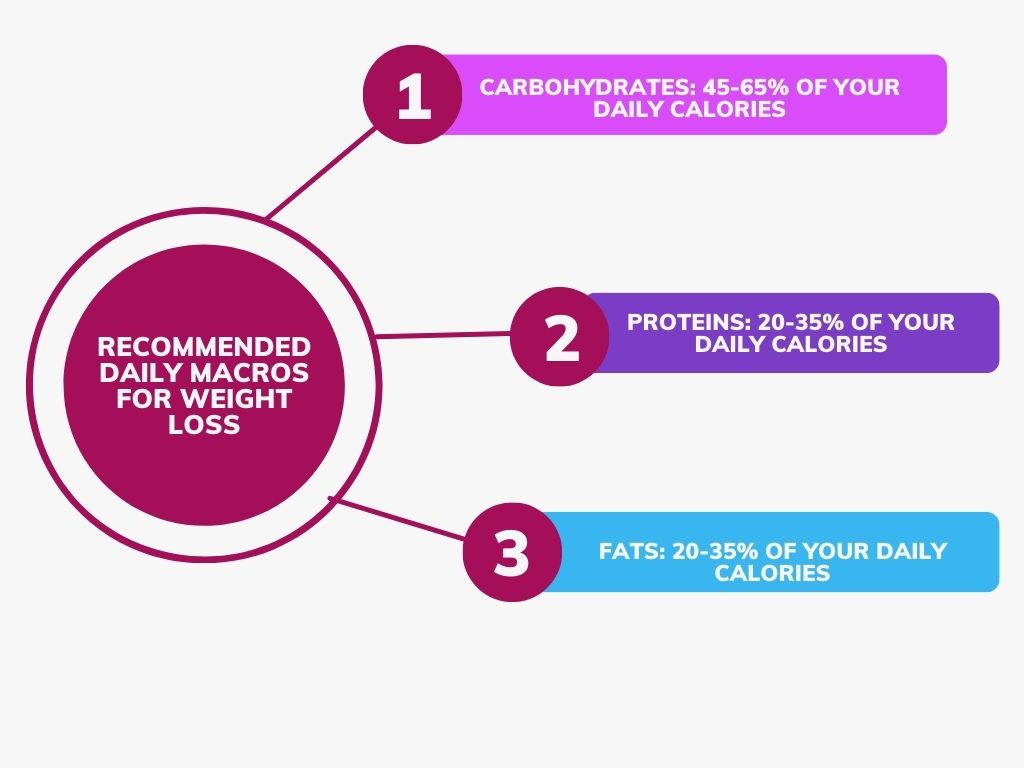In the realm of weight loss, the significance of macronutrients often takes center stage. Macronutrients, namely carbohydrates, proteins, and fats, are the building blocks of our diet and play a pivotal role in fueling our bodies and influencing our weight management efforts. Striking the right balance among these macronutrients is crucial for optimizing fat loss while preserving lean muscle mass. This comprehensive guide delves into the world of macronutrient ratios, exploring the ideal proportions for effective weight loss, the necessity of counting macronutrients, and practical strategies for determining your personalized macronutrient ratio.
Understanding Macronutrients and Their Roles:
Macronutrients are the primary nutrients that provide the body with energy and essential building blocks for various physiological processes. Each macronutrient possesses unique characteristics and functions:
- Carbohydrates: The body’s primary source of energy, carbohydrates are classified into simple and complex carbs. Simple carbs, found in sugary foods and refined grains, provide quick energy but lack nutritional value. Complex carbs, present in whole grains, fruits, and vegetables, offer sustained energy and are rich in fiber, vitamins, and minerals.
- Proteins: Essential for building and repairing tissues, proteins are the building blocks of muscles, bones, and skin. They also play a crucial role in hormone production, immune function, and cellular repair.
- Fats: Often misunderstood, fats are vital for hormone production, cell function, and energy storage. Healthy fats, found in nuts, seeds, avocados, and olive oil, contribute to satiety and support overall health.
The Best Macronutrient Ratio for Weight Loss:
The ideal macronutrient ratio for weight loss varies among individuals based on factors like age, activity level, and metabolic rate. However, general guidelines exist to help you achieve your weight loss goals:
- Carbohydrates: Aim for 45-65% of your daily calories from carbohydrates, prioritizing complex carbs over simple carbs.
- Proteins: Target 20-35% of your daily calories from proteins to support muscle mass and promote satiety.
- Fats: Keep your fat intake between 20-35% of your daily calories, focusing on healthy fats from natural sources.
The Importance of Counting Macronutrients:
Counting macronutrients can be a valuable tool for individuals seeking precise control over their weight loss journey. By tracking your macronutrient intake, you gain a deeper understanding of your dietary habits and can make informed adjustments to align with your goals. Macronutrient counting can be particularly beneficial for:
- Weight Loss Plateaus: If you find yourself stuck in a weight loss plateau, counting macronutrients can help identify potential imbalances in your diet and make necessary adjustments.
- Specific Dietary Goals: For individuals with specific dietary goals, such as building muscle or improving athletic performance, macronutrient counting can ensure you’re meeting your nutritional requirements.
- Managing Medical Conditions: Individuals with certain medical conditions, like diabetes or high cholesterol, may benefit from macronutrient counting to manage their dietary intake effectively.
Finding Your Ideal Macronutrient Ratio:
Determining your ideal macronutrient ratio requires a personalized approach. Here are some steps to help you find the right balance:
- Calculate Your Daily Caloric Needs: Use online calculators or consult a registered dietitian to determine your daily calorie requirement based on your age, activity level, and weight loss goals.
- Set Macronutrient Targets: Once you know your daily calorie needs, allocate them among carbohydrates, proteins, and fats based on the recommended ratios mentioned earlier.
- Track Your Macronutrient Intake: Use food tracking apps or a food journal to monitor your daily macronutrient consumption. This will help you identify areas where adjustments may be necessary.
- Make Gradual Adjustments: If you’re not seeing the desired results, make gradual adjustments to your macronutrient ratios. Avoid drastic changes, as they can be counterproductive and lead to nutrient deficiencies.
Recommended daily macros for weight loss
The recommended daily macros for weight loss depend on several factors, including your age, activity level, and weight loss goals. But to get you going, here are some broad guidelines:

Carbohydrates: 45-65% of your daily calories
Aim for complex carbs like whole grains, fruits, vegetables, and legumes.
Limit simple carbs like sugary drinks, processed foods, and refined grains.
Proteins: 20-35% of your daily calories
Pick lean protein sources such as lentils, beans, fish, poultry, and tofu.
Include plant-based proteins if you follow a vegetarian or vegan diet.
Fats: 20-35% of your daily calories
Prioritize healthy fats from nuts, seeds, avocados, olive oil, and fatty fish.
Reduce your intake of processed meals, red meat, and full-fat dairy items that contain saturated and trans fats.
To calculate your daily macronutrient targets, follow these steps:
Determine Your Daily Caloric Needs:
Use an online calculator or consult a registered dietitian to determine your daily calorie requirement based on your age, activity level, and weight loss goals.
Calculate Macronutrient Targets:
Multiply your daily calorie needs by the percentages allocated to each macronutrient:
Carbohydrates: Daily calories x 0.45 to 0.65
Proteins: Daily calories x 0.20 to 0.35
Fats: Daily calories x 0.20 to 0.35
For example, if your daily calorie requirement is 2,000 calories and you aim for a macronutrient ratio of 45% carbs, 30% proteins, and 25% fats:
Carbohydrates: 2,000 calories x 0.45 = 900 calories
Proteins: 2,000 calories x 0.30 = 600 calories
Fats: 2,000 calories x 0.25 = 500 calories
This translates to approximately:
Carbohydrates: 225 grams
Proteins: 150 grams
Fats: 56 grams
Remember, these are general guidelines, and your individual needs may vary. It’s always advisable to consult a registered dietitian or healthcare professional to create a personalized macronutrient plan that aligns with your specific goals and health.
Conclusion:
Achieving effective weight loss requires a balanced approach to macronutrient intake. By understanding the roles of carbohydrates, proteins, and fats, you can create a macronutrient ratio that aligns with your weight loss goals and supports overall health. While counting macronutrients can be a valuable tool, it’s essential to focus on consuming nutrient-dense foods from all food groups. Remember, gradual adjustments and consistency are key to unlocking lasting weight loss success.







